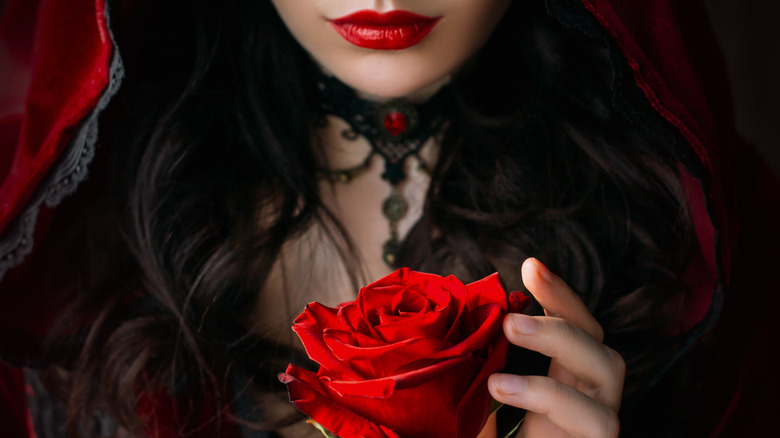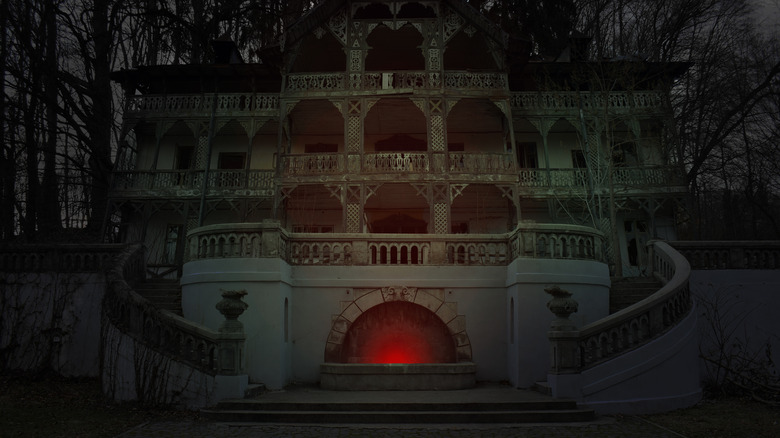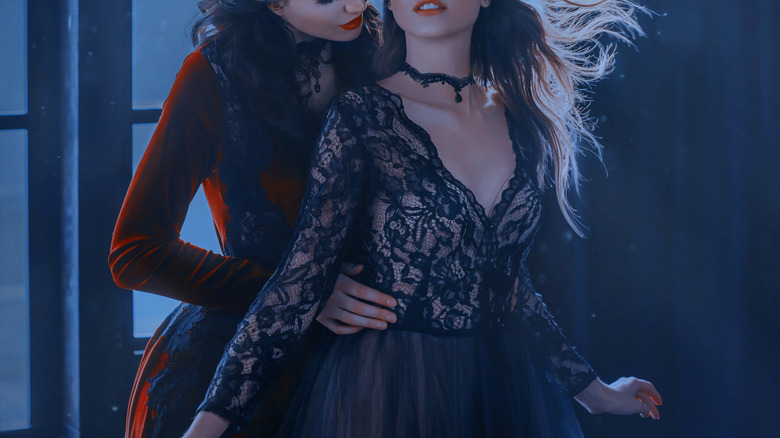The Female Vampire Story That Inspired Dracula
Oh fanged creature of the night, pale stalker of the living, stripping her victims of blood and heat in secluded forested manors, and ... hold on, she's gay? Yes, that is indeed the basic premise of "Dracula's" greatly overshadowed predecessor, "Carmilla." Published in 1872, Joseph Sheridan Le Fanu's early-modern vampire novel predates Bram Stoker's classic by 25 years.
Stoker, who published "Dracula" in 1897, gets credit for consolidating various pieces of pan-European folklore into our modern vision of "vampire," the kind of lore described on National Geographic. Brutal slaughterers of the living who pass on their curse of immortality to others at night? Check. High-collared courtiers and debonair conversationalists by day? Check. Wealthy owners of castles filled with diaphanously-clad harems? Check. Add some garlic, holy water, stakes through the heart, and a dash of the truly horrific 15th-century Transylvanian tyrant Vlad the Impaler, aka "Dracula," and you've got everything you need to spawn sequels for over a century.
Granted, Le Fanu's "Carmilla" is far tamer and far less complex than Stoker's overlong, ponderously paced narrative. "Dracula" is an epistolary novel, written like a series of letters, with journal entries and such. This was a pretty standard convention popularized by English author Samuel Richardson ("Pamela" and "Clarissa" in 1740 and 1747, respectively), itself arguably an evolved form of the "dialogues" genre — folks talking and debating — going all the way back to philosophers like Plato. "Carmilla," by contrast, is a short novella, more of a spooky nighttime tale than anything else.
An eerie, psychological ghost story
The narrative of "Carmilla" is exceedingly simple, and can be read in a single night. It's also got (spoilers) all the obvious tells that we 21st-century folk have come to recognize as staples of the genre: the questionable parentage of a hauntingly beautiful young lady, said young lady vanishing from her room at night, reports of vicious countryside murders, an onlooker who tells the story (because this person can't have died and then told the tale), some rich folks who own a big house in the woods, and so on.
In 1872, this was all new enough to inspire "Dracula," as The Toast and Nerdist discuss. Tons of elements from "Carmilla" pop up in Stoker's novel, enough to securely say that it influenced details in the work, if not overarching concepts. Granted, Stoker was also influenced by things like a disturbed mother who was afraid of going outside because of a cholera outbreak in Sligo, Ireland, during her younger years (via The Irish Times).
That being said, "Carmilla" does feel unique in style and content, even if only by contrast to the direction that vampire stories have taken since "Dracula." Joseph Sheridan Le Fanu (1814-1873), the writer of "Carmilla," was Irish, same as Stoker. As the Scholarly Publishing Collective puts it, Le Fanu is considered "a master of the psychological ghost story as well as a pioneer of the story of detection." "Carmilla" focuses on eerie mystery, not gore (although it does feature a knock-out, final combat scene).
The original lesbian vampire tale
Much of the renewed, recent interest in "Carmilla" relates to the book's implied lesbianism between the eternally young, beautiful, and knowing vampire, Carmilla, and the first-person narrator, the actually young and naïve Laura. It's a well-worn "corruption of the innocent through vivacious female sexuality" paradigm, but one which was definitely eyebrow-raising for its time. The lesbianism is framed like romantic adoration between the two girls, and contains zero explicitness. There are a lot of sighs, admiring glances, and light touches — that kind of thing. Over the course of the book, Laura sees visions of a ghostly, black cat-creature in her dreams, and grows sickly as Carmilla uses their attachment to more or less absorb her life-force.
To illustrate, here's a quote (via Slate): "With gloating eyes she drew me to her, and her hot lips traveled along my cheek in kisses; and she [Carmilla] would whisper, almost in sobs, 'You are mine, you shall be mine, you and I are one for ever.'" Shades of Words quotes, "Shy and strange was the look with which she quickly hid her face in my neck and hair, with tumultuous sighs, that seemed almost to sob, and pressed in mine a hand that trembled. Her soft cheek was glowing against mine."
For the curious, "Carmilla" is one of those books available in the public domain because its copyright has expired. You can read the whole thing (and "Dracula," too, for that matter) on sites like Project Gutenberg.


